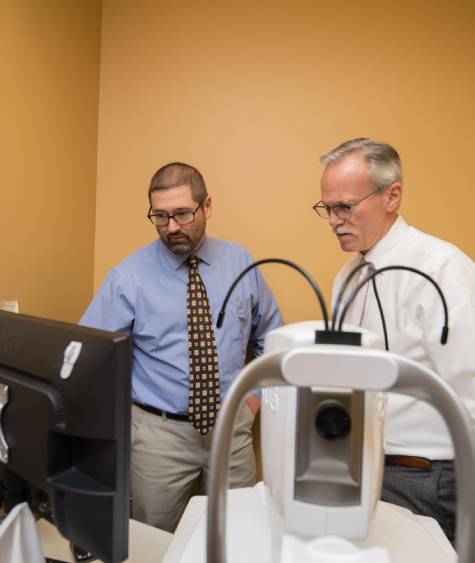
Cataracts
A cataract is a cloudy or opaque area in the normally clear lens of the eye. Depending upon its size and location, it can interfere with normal vision. Most cataracts develop in people over age 55, but they occasionally occur in infants and young children. Usually, cataracts develop in both eyes, but one may be worse than the other. There are a few different types of Cataracts, including:
- A nuclear cataract is located in the center of the lens. The nucleus tends to darken with age, changing from clear to yellow and sometimes brown.
- A cortical cataract affects the layer of the lens surrounding the nucleus. The cataract looks like a wedge or a spoke.
- A posterior capsular cataract is found in the back outer layer of the lens. This type often develops more rapidly.
Causes & Risk Factors
Most cataracts are due to age-related changes in the lens of the eye that cause it to become cloudy or opaque. However, other factors can contribute to cataract development, including:
Diabetes mellitus. People with diabetes are at higher risk for cataracts.
Drugs. Certain medications are associated with cataract development. These include:
- Corticosteroids.
- Chlorpromazine and other phenothiazine related medications.
Ultraviolet radiation. Studies show an increased chance of cataract formation with unprotected exposure to ultraviolet (UV) radiation.
Smoking. There is possibly an association between smoking and increased lens cloudiness.
Alcohol. Several studies show increased cataract formation in patients with higher alcohol consumption compared with people who have lower or no alcohol consumption.
Nutritional deficiency. Although the results are inconclusive, studies suggest an association between cataract formation and low levels of antioxidants (for example, vitamin C, vitamin E, and carotenoids). Further studies may show that antioxidants can help decrease cataract development.
Family History. If a close relative has had cataracts, there is a higher chance of developing a cataract.
Rarely, cataracts are present at birth or develop shortly after. They may be inherited or develop due to an infection (such as rubella) in the mother during pregnancy. A cataract may also develop following an eye injury or surgery for another eye problem, such as glaucoma.
Symptoms
Cataracts generally form very slowly. Signs and symptoms of a cataract may include:
Blurred or hazy vision.
Reduced-intensity of colors.
Increased sensitivity to glare from lights, particularly when driving at night.
Increased difficulty seeing at night.
Change in the eye’s refractive error, or eyeglass prescription.
Diagnosis
Patient history to determine if vision difficulties are limiting daily activities and other general health concerns affecting vision.
Visual acuity measurement to determine to what extent a cataract may be limiting clear distance and near vision.
Refraction to determine the need for changes in an eyeglass or contact lens prescription.
Evaluation of the lens under high magnification and illumination to determine the extent and location of any cataracts.
Evaluation of the retina of the eye through a dilated pupil.
Measurement of pressure within the eye.
Supplemental testing for color vision and glare sensitivity.
Further testing may be needed to determine how much the cataract is affecting vision and to evaluate whether other eye diseases may limit vision following cataract surgery.
Using the information from these tests, your doctor of optometry can determine if you have cataracts and advise you on your treatment options.
Treatment
Cataract treatment is based on the level of visual impairment they cause. If a cataract minimally affects vision, or not at all, no treatment may be needed. Patients may be advised to monitor for increased visual symptoms and follow a regular check-up schedule.
In some cases, changing the eyeglass prescription or adding anti-glare coating may provide temporary vision improvement.
When a cataract progresses to the point that it affects a person’s ability to do normal everyday tasks, surgery may be needed. Cataract surgery involves removing the lens of the eye and replacing it with an artificial lens. The artificial lens requires no care and can significantly improve vision. Some artificial lenses have the natural focusing ability of a young healthy lens. Once a cataract is removed, it cannot grow back.
Two approaches to cataract surgery are generally used:
Small-incision cataract surgery involves making an incision in the side of the cornea (the clear outer covering of the eye) and inserting a tiny probe into the eye. The probe emits ultrasound waves that soften and break up the lens so it can be suctioned out. This process is called phacoemulsification.
Contact our eye care staff today to schedule your appointment!
Your vision is important to us, and we’re here to help you maintain and improve it. We look forward to hearing from you.
